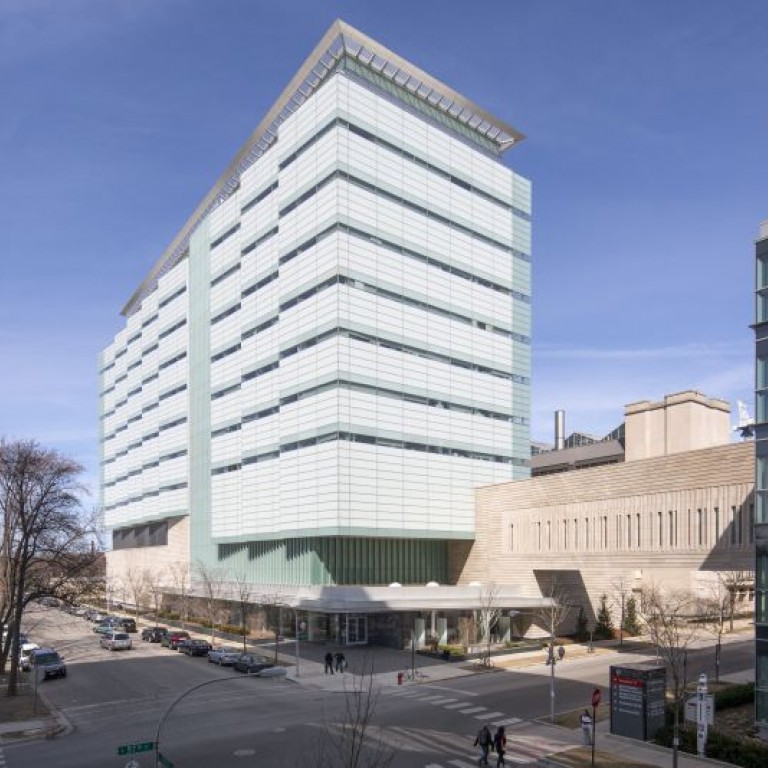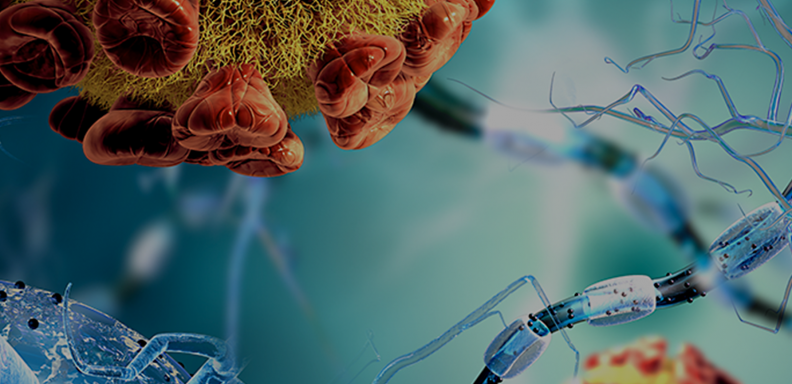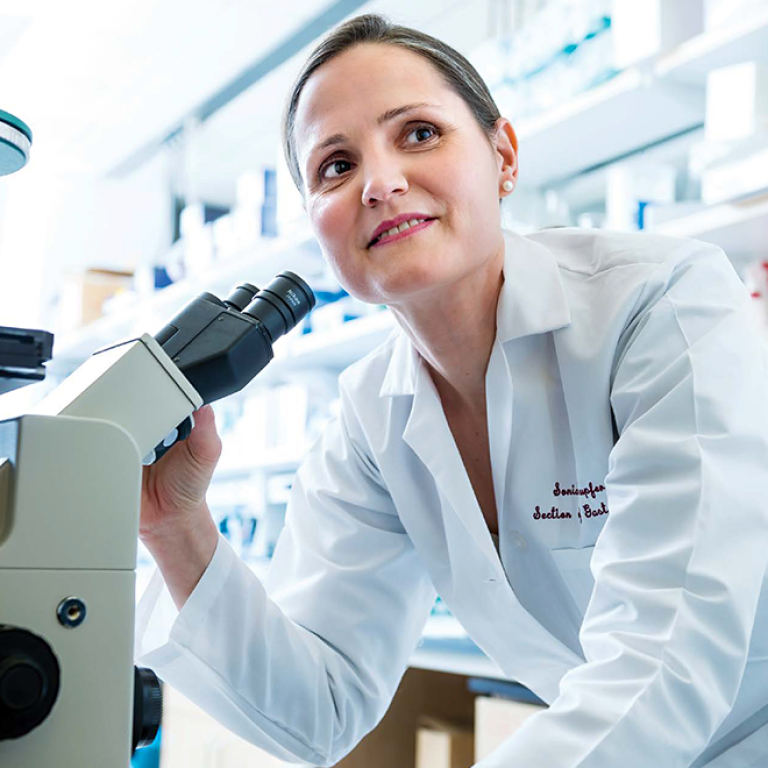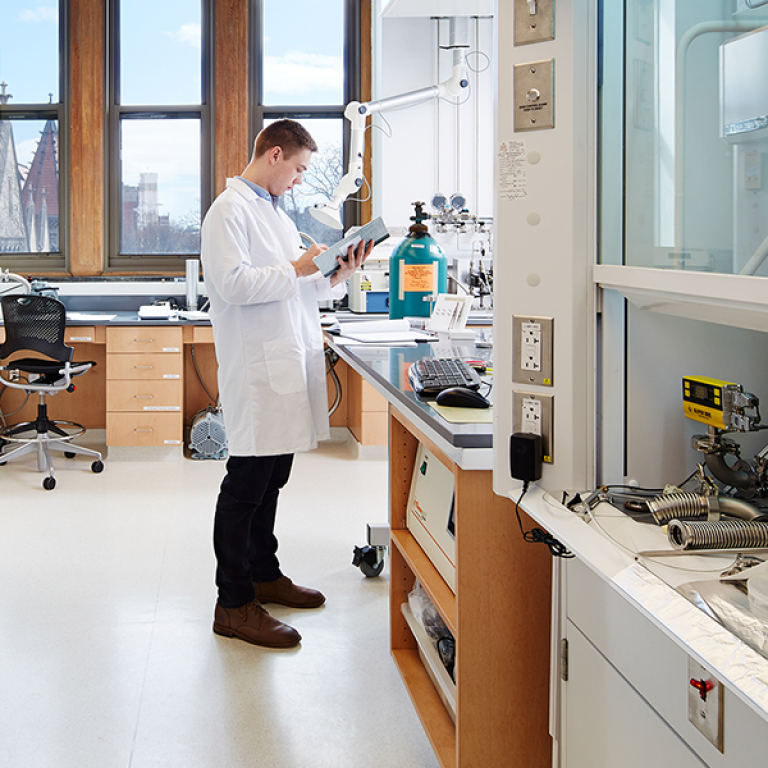Nearly a quarter-century ago, Eugene Chang, MD’76, was studying inflammatory bowel diseases, chronic yet poorly understood conditions marked by diarrhea, pain and fatigue — sometimes with life-threatening complications.
Cases of IBD had been rising for decades, but researchers at the time couldn’t determine why. The cause wasn’t just genetics, environmental factors or even one triggering pathogen. Chang suspected part of the answer could lie within our own gut microbiome — an ever-changing network of trillions of microbes that has co-evolved over time to help the body digest food.
Clearly, these bacteria were doing far more than just digesting. “It dawned on us that the gut microbes were affecting our gene expression,” said Chang, Martin Boyer Professor of Medicine at the University of Chicago.
This story appeared in Medicine on the Midway magazine. Read the Spring 2024 issue here.
The hunch was so strong that Chang retooled his namesake lab in 2000 to focus on the microbiome, collaborating with scientists at Argonne National Laboratory and the Marine Biological Laboratory, and using the latest technologies to study microbes in detail.
Some colleagues questioned the pivot. “There was so little known about the microbiome, and most people were very skeptical that it could be studied,” Chang said. “You’re dealing with trillions of microbes. How do you sort that out?”
Today, the pursuit is booming at the University of Chicago. The gut microbiome has been implicated in a host of diseases and conditions, including those that affect the gastrointestinal tract. It has also been linked to metabolic diseases like diabetes and obesity, cancers, complex immune diseases, allergies, developmental abnormalities and neurological disorders.
As researchers untangle the web of microbiome and host, University teams are developing new breakthroughs that include management tools for IBD, metabolites to treat allergies and probiotics to improve liver disease outcomes.
“Our microbiome medicine and research programs are incredibly strong because of robust multidisciplinary collaborations,” said Chang, who in 2008 worked with Alexander Chervonsky, MD, PhD, and Betty Theriault, DVM, to create the Gnotobiotic Mouse Facility to study microbes’ behavior in germ-free mice — an effort that launched a tidal wave of research at the University.
“Our tools are getting better, and now we can model and simulate conditions to form and test hypotheses that translate into research directions that advance precision medicine.”
Delicate balance, hard questions
When the gut microbiome is healthy and functional, it lives in concert with many of the body’s biological processes, such as metabolism and immunity.
Microbes play a key role in extracting nutrients from the food we eat, but they also release metabolites (small molecules that enter the blood stream, affecting systems throughout our bodies) and produce antimicrobial substances to protect their host from external pathogens.
This microbial network is ever-evolving — depending on a person’s diet, environment, genetics and whether they have recently taken antibiotics — and it varies across ages and cultures.
“The gut microbiome impacts all of our physiology, and when it’s thrown off balance, that will predispose to many different kinds of diseases,” said Cathryn Nagler, PhD, Bunning Food Allergy Professor of Pathology, Medicine, Pediatrics and the Pritzker School of Molecular Engineering.
Consider the United States, where modern-day environments have removed many microbes that humans lived with for thousands of years, and diets have proliferated that lack fruits and vegetables to help diversify the gut’s microbial membership and functions. Scientists theorize that these scenarios contribute to a rise in allergies and autoimmune conditions such as diabetes.
Over the past decade, Nagler said, microbiome researchers have moved beyond identifying which bacteria class is a target to examining host-microbiota interactions on a molecular level.
Progress and demand have led the University to create state-of-the-art microbiome research facilities and services — including the Duchossois Family Institute (DFI), the Microbiome Center and the Microbiome Medicine Program — as well as partnerships with affiliate institutions. Established in 2017, the DFI is led by renowned infectious diseases expert Eric Pamer, MD, Donald F. Steiner Professor of Medicine, Pathology, and Microbiology.
Additionally, UChicago was selected as one of the first human demonstration projects by the National Institutes of Health (NIH) Human Microbiome Project; it has since garnered numerous research grants from the NIH and other funding agencies.
Clear link to diabetes
Although an unbalanced microbiome has been linked to diseases throughout the body, many studies show correlation, not causation. Still, the gut microbiome has the clearest connection with conditions that affect the gastrointestinal tract — including IBD, liver disease and diabetes.
In a study published in Cell Host & Microbe last year, Chervonsky, Professor of Pathology and Medicine, showed that when diabetes-prone mice were given a diet based on the milk protein casein, it helped prevent them from developing Type 1 diabetes. In fact, their insulin-producing cells had improved function, and their autoimmune response was limited.
But when gluten was added into their diet, it overrode the protective effects of casein. The research team found when gluten is eaten, Enterococcus faecalis (E. faecalis), a common bacterium in the gut, secretes enzymes that digest the gluten. This process releases lipopolysaccharides (LPS) — components of non-native “gram-negative” bacteria.
That, in turn, stimulates the immune system to respond to the gut, which overpowers the protection given by casein and can lead to autoimmunity.
“Finding LPS was a surprise that we definitely did not expect, but it must be coming with gluten somehow,” Chervonsky said. “There are gram-negative bacteria everywhere in the soil, so maybe it’s associated with where the grains are grown, or it is contaminated in storage.”
Many of the microbes in the gut microbiome are obligate anaerobes, meaning they cannot live in an oxygenated environment. Instead of generating energy by respiring (“breathing”) oxygen, like most cells do, microbes can respire metabolites, which can then travel throughout the body and affect health.
Sam Light, PhD, Neubauer Family Assistant Professor of Microbiology, recently discovered that certain anaerobic microbes convert dietary protein into a small molecule called imidazole propionate, which impairs glucose tolerance. He and his team are now studying how these microbes contribute to the development of Type 2 diabetes.
“We’re trying to find exactly which gut microbes make this compound and figure out what we can do to prevent them from doing so,” Light said. “That could be a dietary intervention that would prevent it from being produced, or we could introduce another bacteria that could compete metabolically.”
Insights on COVID-19, liver disease
For those who already suffer from certain diseases, an unbalanced microbiome can lead to severe or even deadly outcomes. During the early days of the COVID-19 pandemic, Bhakti Patel, MD, Assistant Professor of Medicine, was trying to figure out why some relatively healthy patients ultimately died from the virus and others recovered.
A study of the microbiomes of COVID-19 patients hospitalized in the ICU at the University of Chicago Medicine between September 2020 and May 2021 offered new insights. “With the technology provided by the DFI, we can measure the microbiome function and potentially customize interventions that restore someone to a healthier state,” said Patel, who workedwith Pamer and a team to analyze those patients’ fecal samples.
Their findings: the COVID-19 patients who suffered lung failure and died had more of a group of bacteria called Proteobacteria in their gut microbiome, and they also had lower levels of secondary bile acids and less of a metabolite called desaminotyrosine.
The resulting study, published in Nature Communications, showed that the composition of the gut microbiome and metabolites the microbes produce could predict the trajectory of patients with severe COVID-19. Patel called the discovery “a paradigm shift” in microbiome research.
A microbiome-focused analysis also shed new light on liver disease patients who have a high incidence of infections from drug- or antibiotic-resistant bacteria.
Matthew Odenwald, PhD’15, MD’17, a former gastroenterology fellow in Pamer’s lab, has studied fecal samples of more than 250 patients hospitalized with liver disease. He, too, found that these patients had reduced microbiome diversity and high abundances of potential pathogens, and lacked certain metabolites that can impact immune defenses.
But a portion of those who had received lactulose — a synthetic sugar commonly given to liver disease patients to treat hepatic encephalopathy — had more gut bacteria called Bifidobacteria. Expansion of this group of bacteria inhibited growth of antibiotic-resistant bacteria, and it was associated with reduced rates of serious infections and prolonged survival.
Odenwald, now an Assistant Professor at the University of Chicago, along with Christopher Lehmann, MD, and Pamer, has received Food and Drug Administration approval to conduct a clinical trial that will provide probiotics — strains of bacteria in oral capsules — to liver disease patients. The goal: to test whether the bacteria engraft in the gut and positively affect clinical outcomes.
“To be able to do this translational work — from bedside to bench to back to bedside — is a pretty unique opportunity here at the University of Chicago,” Odenwald said.
‘A completely new frontier’
Identifying intricate patterns and behaviors is key to answering bigger questions. Chang and his group discovered a novel antimicrobial peptide (AMP) produced by unique immune cells of the gut called Paneth cells. The peptide was identified as peptide YY, a known gut hormone produced by endocrine cells that is important for controlling appetite.
However, the form made and secreted by Paneth cells plays a very different and vital role that maintains intestinal fungi in a state of commensalism.
“This was an important finding because so little was known about how our body controls fungi that are part of the gut microbiome,” said Chang, whose findings were recently published in Science. “We know that they’re there, but now know a bit more about how we keep them under control and in states that benefit us.”
Erin Adams, PhD, is taking a different approach to study of the microbiome by investigating the structure of microbial proteins, finding one that has the same structure as proteins created by pathogenic microbes. But this protein, she said, seems to come from normal bacterial interactions in the gut, leading to questions about the origins and roles of these proteins.
“Does this mean that this protein allowed these microbes to colonize our guts without taking over as they co-evolved with humans?” said Adams, Joseph Regenstein Professor of Biochemistry and Molecular Biology. “Was this co-opted from pathogenic bacteria to allow for some tolerance by our immune systems, or was it co-opted by the pathogenic bacteria?”
Nagler, who studies the gut microbiome as the key to curing food allergies, has analyzed bacteria in the Clostridia class down to their flagella, which propel them around the gut. A study from her research group shows that flagella on Clostridia stimulate the immune system far differently than flagella on pathogenic bacteria — a link that hadn’t been identified.
“That’s what makes microbiome research so exciting,” Nagler said. “It’s the ‘Wild West’ of science, a completely new frontier. The more we find out, the more we find out we don’t know.”
Turning innovation into intervention
Although new findings and published research on the gut microbiome have increased exponentially, many questions remain.
First, there is no universal agreement on what constitutes a healthy microbiome, since it can vary so much across age and cultures. Second, scientists still hope to disentangle the relationship between the gut microbiome and diseases beyond the GI tract.
The one thing scientists agree on is that prevention is easier than treatment. Which is why University experts are hopeful that more answers are within reach. “There has been a lot of hype and maybe some disappointment, but now we’re beginning to figure out exactly the ways in which these microbes interact with our bodies,” Light said.
Researchers know, for instance, that delivering key bacteria and the metabolites they produce to the gut is essential in rebalancing the gut microbiome. But it can be difficult to get bacteria to engraft in the gut.
Nagler and Jeffrey Hubbell, PhD, Eugene Bell Professor in Tissue Engineering, solved this problem by developing a polymer molecule designed to deliver metabolites directly to the gut.
The polymers, called micelles, are suspended in water and travel through the stomach to the small intestine and cecum, where they release the metabolite butyrate. Once there, butyrate helps repair intestinal barrier function and helps prevent food allergies.
The treatment was successful in mice, and the team formed startup ClostraBio to bring it to clinical trials to treat food allergies.
Chang, meanwhile, has developed a marker panel to assess how well a person’s microbiome is functioning. His startup, Gateway Biome, has filed provisional patents and is negotiating with manufacturers to produce home collection kits for the stool samples needed for the panel. The team is also conducting clinical studies to develop marker panels for all stages of life.
“We think this will be not only diagnostic but a very effective management tool that can guide physicians in making medical decisions and determining the right therapy to help repair and restore the health of their patients’ microbiomes,” Chang said.
Finding solutions to restore the microbiome is the next logical step — and it’s already underway, said Lehmann, an Assistant Professor of Medicine, who has also studied the connection between a healthy microbiome and reduced postoperative infections after liver transplant.
The Biological Sciences Division has a biobank containing thousands of bacteria, analyzed and categorized based on their genomes and what metabolites they produce. The University of Chicago also recently opened a Good Manufacturing Practices-compliant facility, where scientists can produce, filter and freeze-dry key gut bacteria from healthy donors and pack them into pharmaceutical-grade capsules.
Large or small, every step in the journey has a shared purpose. “Understanding the microbiome, testing the microbiome’s health and restoring the microbiome are all crucial new tools we can add to our arsenal,” Lehmann said.



